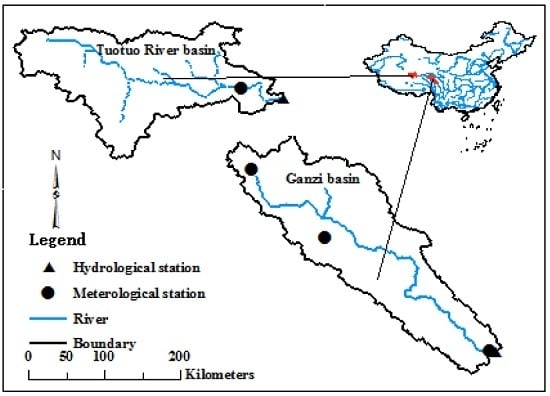Improving Streamflow Prediction Using Remotely-Sensed Soil Moisture and Snow Depth
Abstract
:1. Introduction
- (1)
- (2)
- using RS-based SM to calibrate hydrological model SM predictions [14],
- (3)
- (4)
2. Method
2.1. HBV Hydrological Model
2.2. Data Assimilation Method (EnKF)
2.3. Separation of Solid Precipitation and Liquid Precipitation
2.4. SMART Rainfall Correction Method
2.5. SDART Snowfall Method
2.6. Synthetic Experiments
2.7. Error Models for Data Assimilation Experiments
2.8. Ground Sites and Remote Sensing Data
3. Results
3.1. HBV Calibration and Validation
3.2. Synthetic Experiment Results
3.2.1. Impact of Precipitation Error
3.2.2. Streamflow Correction
3.3. Real Data Experiment Results
3.3.1. Tuotuo River Basin
3.3.2. Ganzi Basin
3.3.3. Flood Peak Values
4. Conclusions
Acknowledgments
Author Contributions
Conflicts of Interest
Abbreviations
| SM | Soil moisture |
| SD | Snow depth |
| SMOS | Soil Moisture and Ocean Salinity |
| SMAP | Soil Moisture Active/Passive |
| ASCAT | Advanced Scatterometer |
| METOP | Meteorological Operational |
| RS | Remotely-sensed |
| DA | Data assimilation |
| SMART | Soil Moisture Analysis Rainfall Tool |
| SDART | Snow Depth Analysis Rainfall Tool |
| HBV | Hydrologiska Byrans Vattenbalansavdelning |
| EnKF | Ensemble Kalman filter |
| SCE | Shuffled Complex Evolution |
| SWI | Soil water index |
| OL | Open Loop |
References
- Alvarez-Garreton, C.; Ryu, D.; Western, A.W.; Su, C.H.; Crow, W.T.; Robertson, D.E.; Leahy, C. Improving operational flood ensemble prediction by the assimilation of satellite soil moisture: Comparison between lumped and semi-distributed schemes. Hydrol. Earth Syst. Sci. 2015, 19, 1659–1676. [Google Scholar] [CrossRef]
- Aubert, D.; Loumagne, C.; Oudin, L. Sequential assimilation of soil moisture and streamflow data in a conceptual rainfall-runoff model. J. Hydrol. 2003, 280, 145–161. [Google Scholar] [CrossRef]
- Brocca, L.; Melone, F.; Moramarco, T.; Wagner, W.; Naeimi, V.; Bartalis, Z.; Hasenauer, S. Improving runoff prediction through the assimilation of the ascat soil moisture product. Hydrol. Earth Syst. Sci. 2010, 14, 1881–1893. [Google Scholar] [CrossRef]
- Thirel, G.; Salamon, P.; Burek, P.; Kalas, M. Assimilation of MODIS snow cover area data in a distributed hydrological model. Hydrol. Earth Syst. Sci. Discuss. 2011, 8, 1329–1364. [Google Scholar] [CrossRef]
- Kumar, S.V.; Peters-Lidard, C.D.; Mocko, D.; Reichle, R.; Liu, Y.; Arsenault, K.R.; Xia, Y.; Ek, M.; Riggs, G.; Livneh, B.; et al. Assimilation of remotely sensed soil moisture and snow depth retrievals for drought estimation. J. Hydrometeorol. 2014, 6, 2446–2469. [Google Scholar] [CrossRef]
- Crow, W.; Ryu, D. A new data assimilation approach for improving runoff prediction using remotely-sensed soil moisture retrievals. Hydrol. Earth Syst. Sci. 2009, 13, 1–16. [Google Scholar] [CrossRef]
- Chen, F.; Crow, W.T.; Starks, P.J.; Moriasi, D.N. Improving hydrologic predictions of a catchment model via assimilation of surface soil moisture. Adv. Water Res. 2011, 34, 526–536. [Google Scholar] [CrossRef]
- Lü, H.; Hou, T.; Horton, R.; Zhu, Y.; Chen, X.; Jia, Y.; Wang, W.; Fu, X. The streamflow estimation using the xinanjiang rainfall runoff model and dual state-parameter estimation method. J. Hydrol. 2013, 480, 102–114. [Google Scholar] [CrossRef]
- Kerr, Y.H.; Waldteufel, P.; Wigneron, J.P.; Martinuzzi, J.; Font, J. Soil moisture retrieval from space: The soil moisture and ocean salinity (smos) mission. IEEE Trans. Geosci. Remote. Sens. 2001, 39, 1729–1735. [Google Scholar] [CrossRef]
- Albergel, C.; Rüdiger, C.; Carrer, D.; Calvet, J.C.; Fritz, N.; Naeimi, V.; Bartalis, Z.; Hasenauer, S. An evaluation of ascat surface soil moisture products with in-situ observations in southwestern france. Hydrol. Earth Syst. Sci. 2009, 13, 115–124. [Google Scholar] [CrossRef]
- Bartalis, Z.; Wagner, W.; Naeimi, V.; Hasenauer, S.; Scipal, K.; Bonekamp, H.; Figa, J.; Anderson, C. Initial soil moisture retrievals from the metop-a advanced scatterometer (ascat). Geophys. Res. Lett. 2007, 34, L20401. [Google Scholar] [CrossRef]
- Goodrich, D.C.; Schmugge, T.J.; Jackson, T.J.; Unkrich, C.L.; Keefer, T.O.; Parry, R.; Bach, L.B.; Amer, S.A. Runoff simulation sensitivity to remotely sensed initial soil water content. Water Resour. Res. 1994, 30, 1393–1405. [Google Scholar] [CrossRef]
- Weissling, B.P.; Xie, H.; Murray, K.E. A multitemporal remote sensing approach to parsimonious streamflow modeling in a southcentral texas watershed, USA. Hydrol. Earth Syst. Sci. Discuss. 2007, 4, 1–33. [Google Scholar] [CrossRef]
- Parajka, J.; Naemi, V.; Bloschl, G.; Wagner, W.; Merz, R.; Scipal, L. Assimilating scatterometer soil moisture data into conceptual hydrologic models at coarse scales. Hydrol. Earth Syst. Sci. 2006, 10, 353–368. [Google Scholar] [CrossRef]
- Pauwels, V.R.N.; Hoeben, R.; Verhoest, N.E.C.; De Troch, F.P.; Troch, P.A. Improvement of toplats-based discharge predictions through assimilation of ers-based remotely sensed soil moisture values. Hydrol. Process. 2002, 16, 995–1013. [Google Scholar] [CrossRef]
- Crow, W.T.; Bindlish, R.; Jackson, T.J. The added value of spaceborne passive microwave soil moisture retrievals for forecasting rainfall-runoff partitioning. Geophys. Res. Lett. 2005, 32, L18401. [Google Scholar] [CrossRef]
- Brocca, L.; Moramarco, T.; Melone, F.; Wagner, W. A new method for rainfall estimation through soil moisture observations. Geophys. Res. Lett. 2013, 40, 853–858. [Google Scholar] [CrossRef]
- Wood, E.F.; Sivapalan, M.; Beven, K. Similarity and scale in catchment storm response. Rev. Geophys. 1990, 28, 1–18. [Google Scholar] [CrossRef]
- Crow, W.; van Den Berg, M.; Huffman, G.; Pellarin, T. Correcting rainfall using satellite-based surface soil moisture retrievals: The soil moisture analysis rainfall tool (smart). Water Resour. Res. 2011, 47, 2924–2930. [Google Scholar] [CrossRef]
- Pellarin, T.; Ali, A.; Chopin, F.; Jobard, I.; Bergs, J.-C. Using spaceborne surface soil moisture to constrain satellite precipitation estimates over west africa. Geophys. Res. Lett. 2008, 35, L02813. [Google Scholar] [CrossRef]
- Chen, F.; Crow, W.T.; Holmes, T.R.H. Improving long-term, retrospective precipitation datasets using satellite-based surface soil moisture retrievals and the soil moisture analysis rainfall tool. J. Appl. Remote Sens. 2012, 6, 063604. [Google Scholar] [CrossRef]
- Lindströ, G.; Johansson, B.; Persson, M.; Gardelin, M.; Bergströ, S. Development and test of the distributed hbv-96 hydrological model. J. Hydrol. 1997, 201, 272–288. [Google Scholar] [CrossRef]
- Aghakouchak, A.; Habib, E. Application of a conceptual hydrologic model in teaching hydrologic processes. Int. J. Eng. Educ. 2010, 26, 1–11. [Google Scholar]
- Lu, H.; Crow, W.T.; Zhu, Y.; Yu, Z.; Sun, J. The impact of assumed error variances on surface soil moisture and snow depth hydrologic data assimilation. IEEE J. Sel. Top. Appl. Earth Obs. Remote. Sens. 2015, 8, 5116–5129. [Google Scholar]
- Duan, Q.; Sorooshian, S.; Gupta, V.K. Optimal use of the sce-ua global optimization method for calibrating watershed models. J. Hydrol. 1994, 158, 265–284. [Google Scholar] [CrossRef]
- Moradkhani, H.; Sorooshian, S.; Gupta, H.V.; Houser, P.R. Dual state-parameter estimation of hydrological models using ensemble kalman filter. Adv. Water Resour. 2005, 28, 135–147. [Google Scholar] [CrossRef]
- Vrugt, J.A.; Gupta, H.V. Real-time data assimilation for operational ensemble streamflow forecasting. J. Hydrometeorol. 2006, 7, 548–564. [Google Scholar] [CrossRef]
- Crow, W.T.; Huffman, G.J.; Bindlish, R.; Jackson, T.J. Improving satellite-based rainfall accumulation estimates using spaceborne surface soil moisture retrievals. J. Hydrometeorol. 2009, 10, 199–212. [Google Scholar] [CrossRef]
- Kienzle, S.W. A new temperature based method to separate rain and snow. Hydrol. Process. 2008, 22, 5067–5085. [Google Scholar] [CrossRef]
- Bergström, S. Development and Application of a Conceptual Runoff Model for Scandinavian Catchments; SMHI Report: Norrköping, Sweden, 1976; p. 134. [Google Scholar]
- Pipes, A.; Quick, M.C. Ubc Watershed Model Users Guide; Department of Civil Engineering; University of British Columbia: Vancouver, BC, Canada, 1977. [Google Scholar]
- Leavesley, G.H.; Lichty, R.W.; Troutman, B.M.; Saindon, L.G. Precipitation-Runoff Modeling System: User’s Manual; Water Resources Investigations Report 83–4238; Us Geological Survey: Denver, CO, USA, 1983.
- Wen, L.J.; Nagabhatla, N.; Lü, S.H.; Wang, S.Y. Impact of rain snow threshold temperature on snow depth simulation in land surface and regional atmospheric model. Adv. Atmos. Sci. 2013, 30, 1449–1460. [Google Scholar] [CrossRef]
- Cherry, J.E.; Tremblay, L.B.; Der.Stephen, J.; Stieglitz, M. Reconstructing solid precipitation from snow depth measurements and a land surface model. Water Resour. Res. 2005, 41, W09401. [Google Scholar] [CrossRef]
- Zhang, Y.; Liu, S.; Ding, Y. Observed degree-day factors and their spatial variation on glaciers in western china. Ann. Glaciol. 2006, 43, 301–306. [Google Scholar] [CrossRef]
- Huffman, G.J.; Adler, R.F.; Bolvin, D.T.; Nelkin, E.J. The trmm multi-satellite precipitation analysis (tmpa). In Satellite rainfall Applications for Surface Hydrology; Springer: Berlin, Germany, 2010; pp. 3–22. [Google Scholar]
- Yong, B.; Hong, Y.; Ren, L.L.; Gourley, J.J.; Huffman, G.J.; Chen, X.; Wang, W.; Khan, S.I. Assessment of evolving trmm-based multisatellite real-time precipitation estimation methods and their impacts on hydrologic prediction in a high latitude basin. J. Geophys. Res. Atmos. 2012, 117, D9. [Google Scholar] [CrossRef]
- Wagner, W.; Lemoine, G.; Rott, H. A method for estimating soil moisture from ers scatterometer and soil data. Remote. Sens. Environ. 1999, 70, 191–207. [Google Scholar] [CrossRef]
- Che, T.; Xin, L.; Jin, R.; Armstrong, R.; Zhang, T. Snow depth derived from passive microwave remote-sensing data in china. Ann. Glaciol. 2008, 49, 145–154. [Google Scholar] [CrossRef]
- Che, T.; Dai, L. China Snow Depth Time Series Data Sets (1978–2012); Cold and Arid Regions Science Data Center at Lanzhou: Lanzhou, China, 2011. [Google Scholar]
- Parajka, J.; Merz, R.; Blöschl, G. Uncertainty and multiple objective calibration in regional water balance modelling: Case study in 320 Austrian catchments. Hydrol. Process. 2007, 21, 435–446. [Google Scholar] [CrossRef]
- Chen, F.; Crow, W.T.; Ryu, D. Dual forcing and state correction via soil moisture assimilation for improved rainfall-runoff modeling. J. Hydrometeorol. 2014, 15, 1832–1848. [Google Scholar] [CrossRef]
- Ryu, D.; Crow, W.T.; Zhan, X.; Jackson, T.J. Correcting unintended perturbation biases in hydrologic data assimilation using ensemble kalman filter. J. Hydrometeorol. 2009, 10, 734–750. [Google Scholar] [CrossRef]

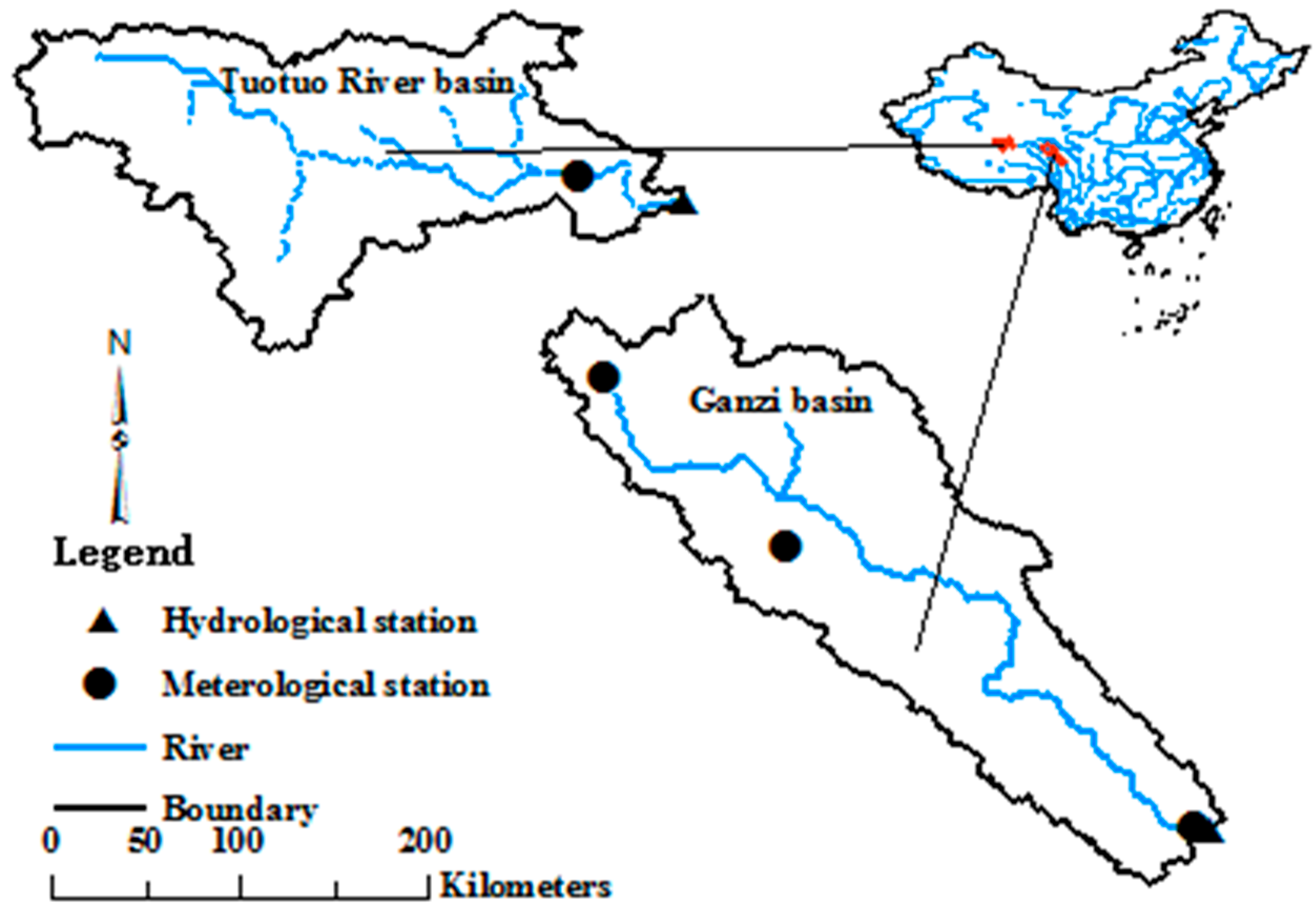
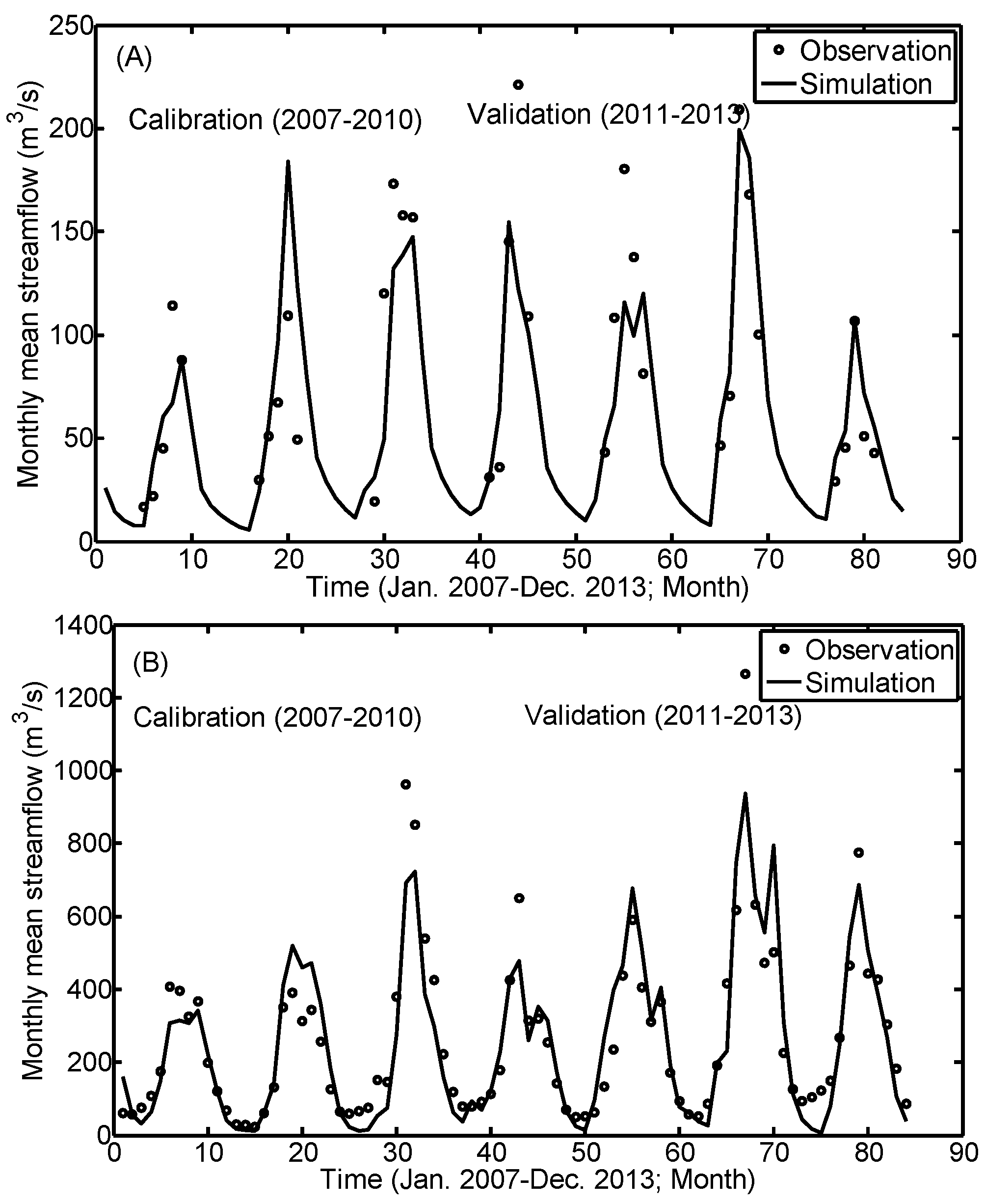
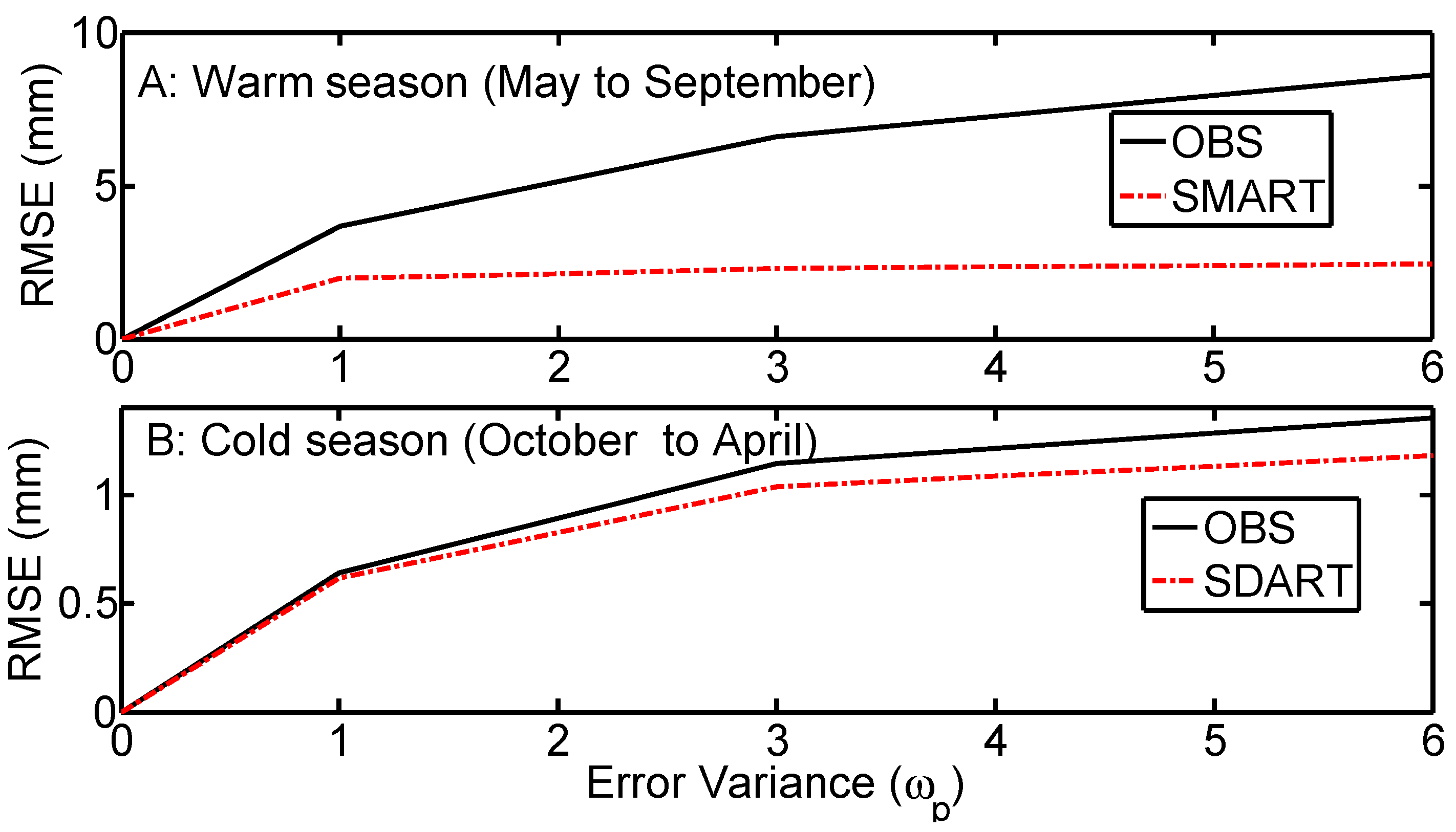
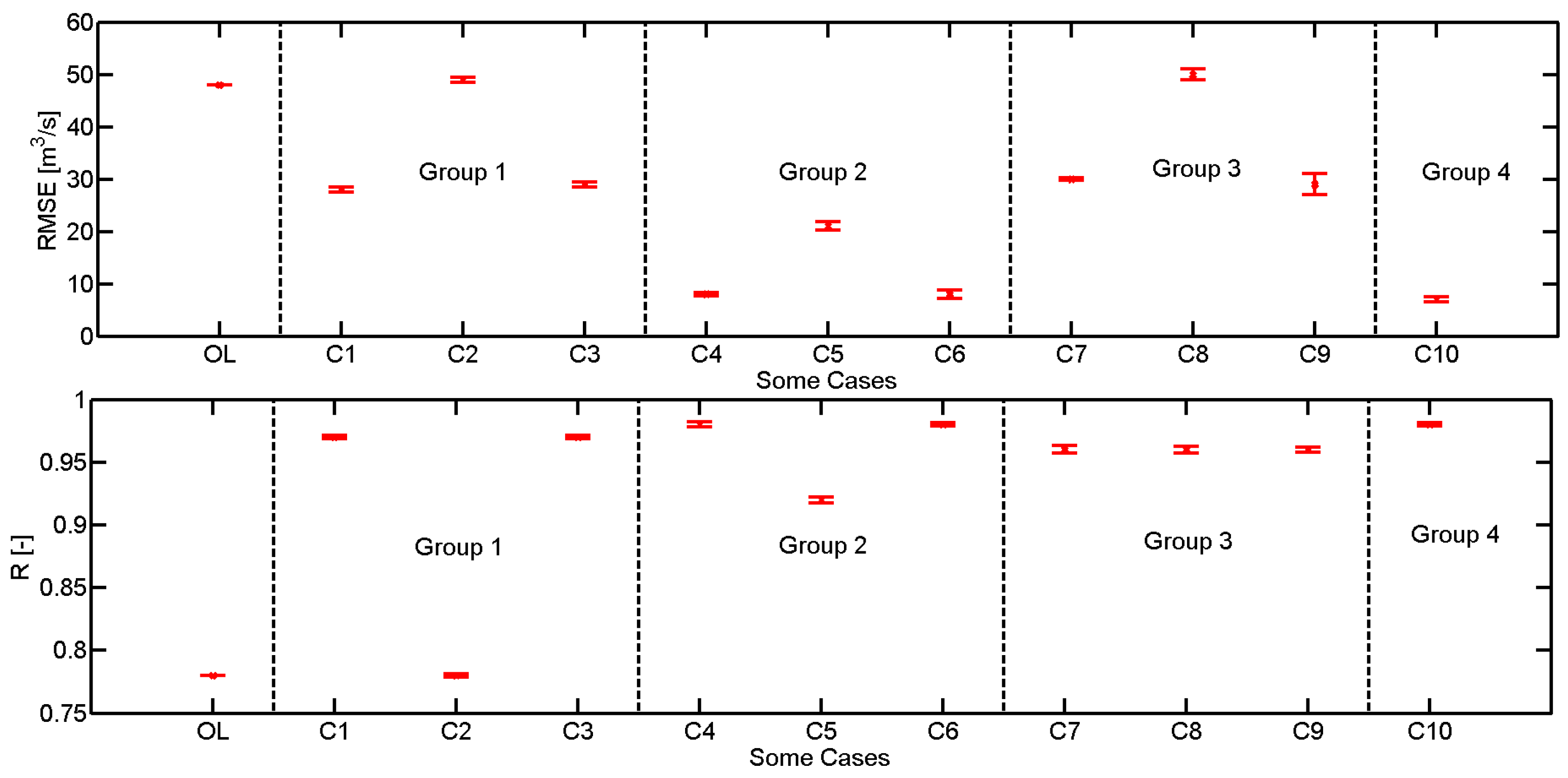
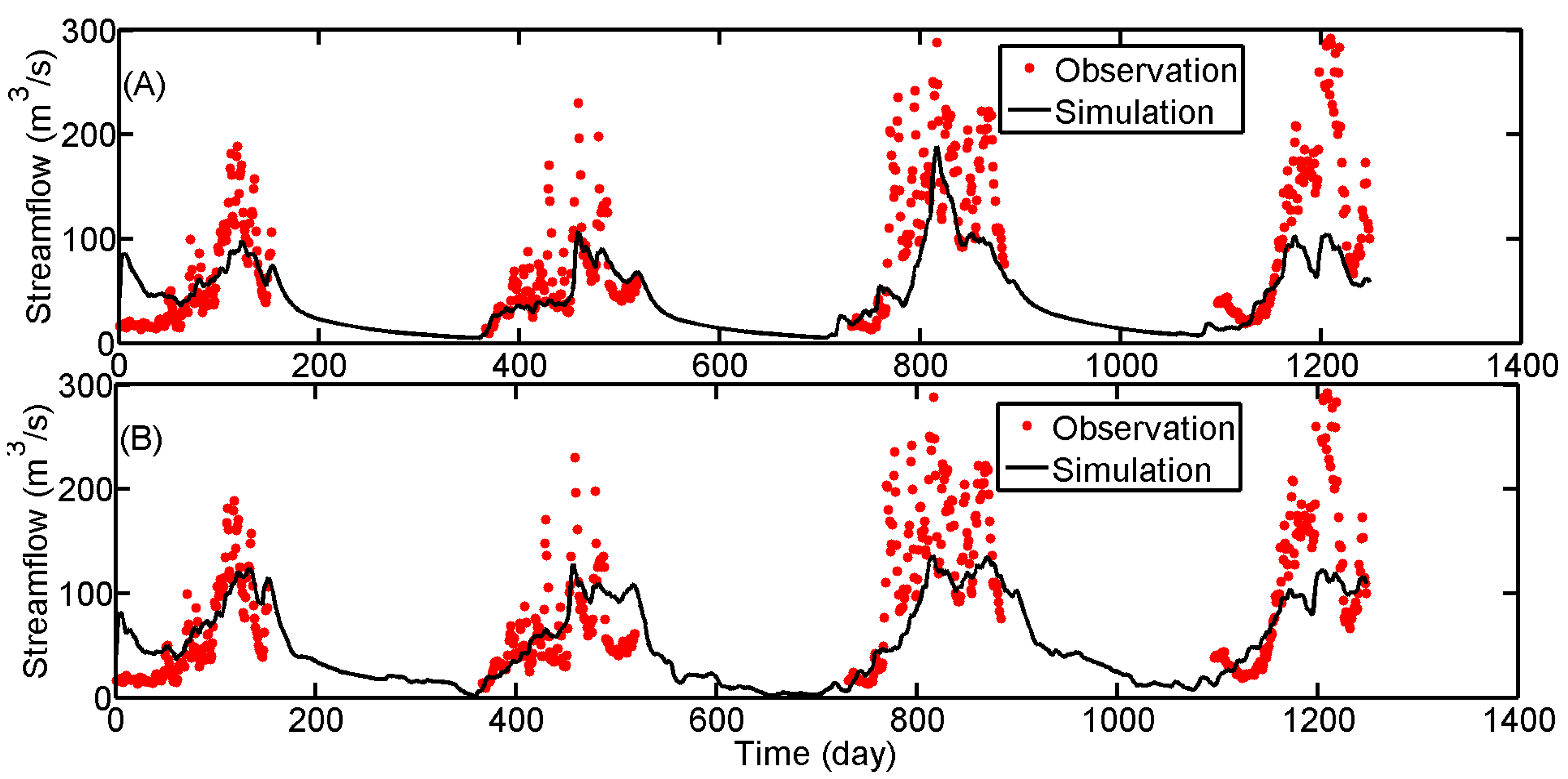
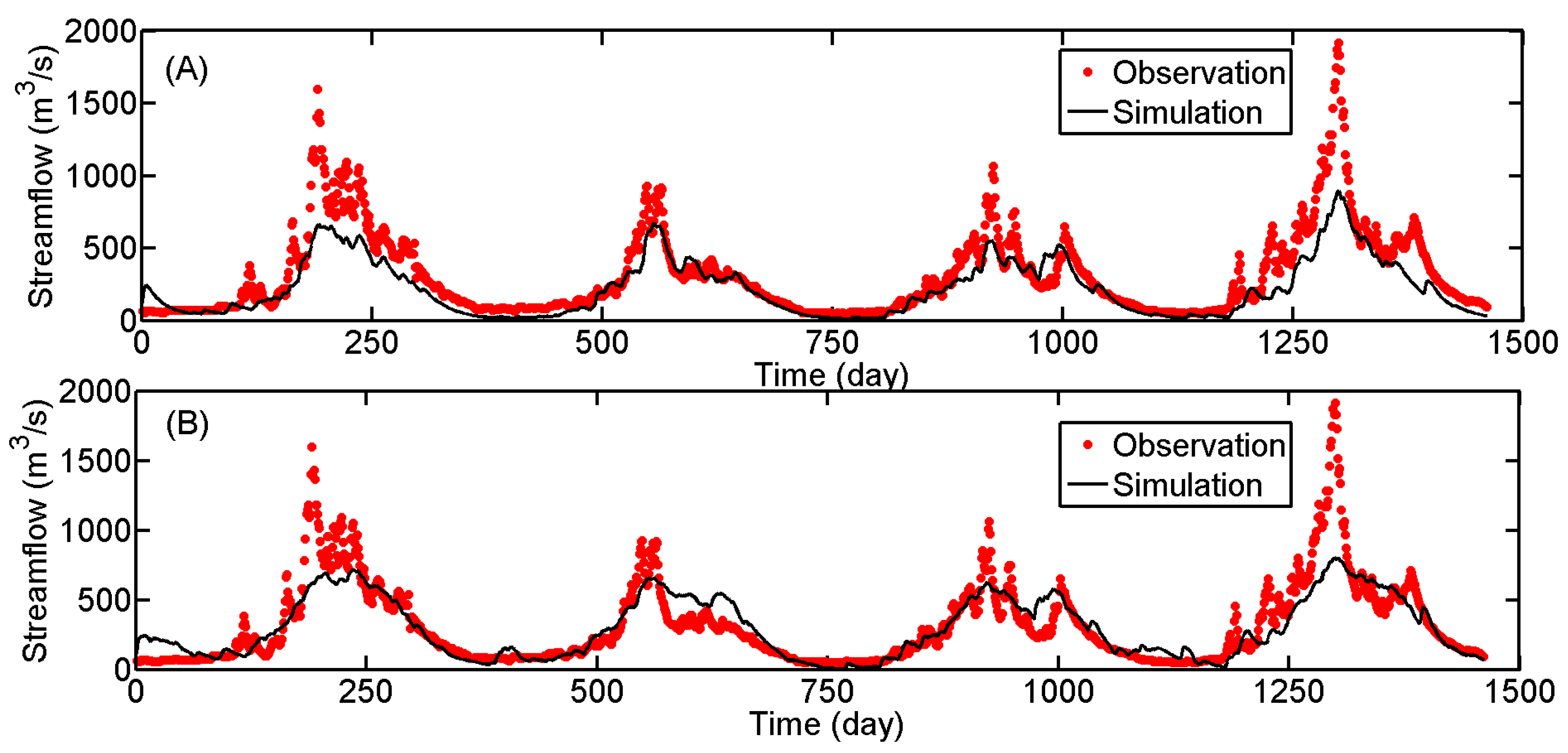
| Parameters, Variables, Input and Output | Physical Meaning | Range | Tuotuo River Basin | Ganzi River Basin | |
|---|---|---|---|---|---|
| Parameters | DD (L·θ−1·T−1) | Degree-day factor | 3–7 | 4.9 | 6.89 |
| β (–) | Model shape coefficient | 1–7 | 1.33 | 1.05 | |
| FC (L ) | Maximum soil storage capacity | 100–200 | 200 | 199 | |
| C (θ−1) | Evapatranspiration parameter | 0.01–0.07 | 0.03 | 0.01 | |
| PWP (L) | Soil permanent wilting point | 90–180 | 94.16 | 90.02 | |
| K0 (T−1) | Recession coefficients | 0.05–0.2 | 0.08 | 0.2 | |
| K1 (T−1) | Recession coefficients | 0.02–0.1 | 0.05 | 0.05 | |
| K2 (T−1) | Recession coefficients | 0.02–0.05 | 0.01 | 0.03 | |
| L (L) | Threshold water level | 2–100 | 50 | 44 | |
| Kp (T−1) | Percolation storage coefficient | 0.01–0.05 | 0.04 | 0.04 | |
| State variables | SD (L) | Snow depth | |||
| SM (L) | Soil moisture | ||||
| SU (L) | Upper reservoir water level | ||||
| SL (L) | Lower reservoir water level | ||||
| Input | P (L) | Precipitation | |||
| T (θ) | Temperature | ||||
| Output | Qs (L3T−1) | Total simulated runoff | |||
| Ea (L) | Actual evapotranspiration | ||||
| Watershed | Criteria | Open Loop | C10 |
|---|---|---|---|
| Tuotuo River | RMSE (m3/s) | 55 | 49 |
| NS (-) | 0.32 | 0.50 | |
| R (-) | 0.72 | 0.72 | |
| Ganzi River | RMSE (m3/s) | 169 | 159 |
| NS (-) | 0.65 | 0.70 | |
| R (-) | 0.89 | 0.90 |
© 2016 by the authors; licensee MDPI, Basel, Switzerland. This article is an open access article distributed under the terms and conditions of the Creative Commons Attribution (CC-BY) license (http://creativecommons.org/licenses/by/4.0/).
Share and Cite
Lü, H.; Crow, W.T.; Zhu, Y.; Ouyang, F.; Su, J. Improving Streamflow Prediction Using Remotely-Sensed Soil Moisture and Snow Depth. Remote Sens. 2016, 8, 503. https://doi.org/10.3390/rs8060503
Lü H, Crow WT, Zhu Y, Ouyang F, Su J. Improving Streamflow Prediction Using Remotely-Sensed Soil Moisture and Snow Depth. Remote Sensing. 2016; 8(6):503. https://doi.org/10.3390/rs8060503
Chicago/Turabian StyleLü, Haishen, Wade T. Crow, Yonghua Zhu, Fen Ouyang, and Jianbin Su. 2016. "Improving Streamflow Prediction Using Remotely-Sensed Soil Moisture and Snow Depth" Remote Sensing 8, no. 6: 503. https://doi.org/10.3390/rs8060503
APA StyleLü, H., Crow, W. T., Zhu, Y., Ouyang, F., & Su, J. (2016). Improving Streamflow Prediction Using Remotely-Sensed Soil Moisture and Snow Depth. Remote Sensing, 8(6), 503. https://doi.org/10.3390/rs8060503





